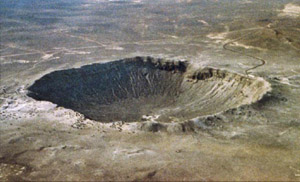Canyon Diablo Meteorite
 Picture credit D. Roddy, USGS | The meteor responsible for the creation of Meteor Crater or Barringer Crater near Flagstaff, Arizona was given the name Canyon Diablo. Fragments of the meteor have been collected around the crater and in Canyon Diablo which lies 3 to 4 miles west of the crater. |
The meteorite is classified as an iron meteorite and the estimated impact time is 50,000 years ago. Fragments of the meteorite have been actively collected since the mid 1800s and there is evidence that fragments were collected and used by pre-historic Native Americans. The biggest fragment is the Holsinger Meteorite with a mass of 639 kg, which is on display in the Meteor Crater Visitor Center on the rim of the crater. The total known mass is on the order of 30,000 kg.
There are more than a dozen identifiable minerals within the predominantly iron meteororite. Very significant for use in geologic dating by means of Pb-Pb isochrons is the troilite mineral consisting of iron sulfide, FeS. This troilite contains the lowest lead ratios ever measured and has become the reference standard for lead dating methods.
| Classification of meteorites |
References:
Description in Wikipedia Canyon Diablo (meteorite)
Solar System Illustration
Solar System Concepts
Reference
Dalrymple
Ch 6
| HyperPhysics********** Astrophysics | R Nave |